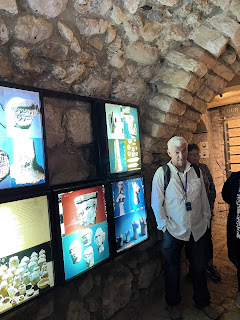We began our tour today in the City of David, the original Jebusite city conquered by David to be used as his capital. Until that occurred, Hebron was the capital under David. It is only 12 acres in size but they have found some tremendous treasures there. Signet rings with a stamp on them from administrators for the Davidic dynasty were found, along with the rooms of a palace and the homes of rich people surrounding it. The water tunnel dug under the city during the time of Hezekiah has been located. This protected the water source during siege. Other seals and buildings were uncovered confirming a Jewish presence in the area for other 3000 years. That goes totally against the narrative put forth by the Arab neighbors of Israel.
Five brave souls walked through Hezekiah’s Tunnel despite the cool temperatures. They are pictured below. We then walked from the City of David through the sewage tunnel to the southern wall area, observing several cisterns along the way. Water is so important. The street level of Jesus’ day was where we were sitting, part of the cardo or shops where pilgrims would buy their sacrifices. Huge stones pushed down from the Temple Mount by the Romans in 70 AD were piled on the street where they landed. One corner special stone piece indicated it was the guardrail like structure where the Levites stood to blow the trumpet for Shabbat or the Festivals. We then rounded the corner and sat on the Southern Steps where we know all Pilgrims used these to enter the Temple area. Jesus walked on these stones several times and taught from them as a 12 year old. The thought of being at the same spot was amazing.
We boarded our bus once again and drove to Ramat Rachel for lunch. That is a kibbutz that sits with a beautiful view of Bethlehem along the Hebron Road. Nir covered our lunch for us today once again and we were all grateful. Our surprise of the day was that instead of going to Israel Museum as planned, we traveled beyond Bethlehem to the Herodian. This is the burial place of King Herod located on a mountain, the top third of which is man-made. It is located right beside the village of Tekoa, home of Amos the prophet and within sight of the Dead Sea. It was this desert region where Jesus was tempted by Satan, within sight of Jerusalem.
The Herodian is another of the amazing construction feats of Herod and it was good to visit there.
We returned home a little early in order to rest for an excursion to Ben Yehuda street in the evening. It was a very fun and insightful day for us. Pics are below.
 |
| Hebrew writing on the wall under Robinson’s Arch |
 |
| Artist conception at Southern Wall steps |
 |
| Panoramic view toward Bethlehem from the Herodian |
 |
| The five who walked Hezekiah’s Tunnel |
 |
| In Hezekiah’s Tunnel |
 |
| Corner adornment of Herod’s Tomb, Herodian |
 |
| Entering the top of the Herodian |
 |
| In Hezekiah’s Tunnel |
 |
| Base of Herod’s tomb, Herodian |
 |
| Sign in the water tunnel at City of David |
 |
| In Hezekiah’s Tunnel |
 |
| Nir explaining Herod’s tomb |
 |
| Steps of the Pool of Siloam |
 |
| Lowell and Karen on top of Herodian |
 |
| City of David, direction of Pool of Siloam |
 |
| Explanation of the water system |
 |
| Model of the Herodian complex |
 |
| Group picture on the Southern Steps |
 |
| Tower on top of Herodian |
 |
| Picture of the City of David |
 |
| Palace retaining wall, City of David |
 |
| Water shaft, City of David |
 |
| Jerusalem, artist rendition and picture from 1967 |
 |
| Climbing stairs to top of Herodian |
 |
| Two directions to explore water shaft |
 |
| Foundation of rich home below palace, City of David |
 |
| Walking the sewer tunnel, toward Southern Steps |
 |
| City of David |
 |
| Toilet in rich home, City of David |
 |
| Stones thrown from Temple Mount to street below |
 |
| City of David |
 |
| Explanation of ruins under Givat parking lot |


































Comments
Post a Comment